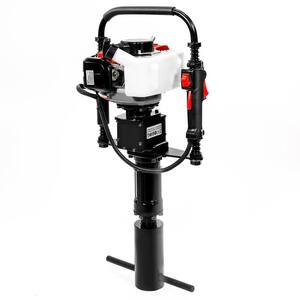

Hammering rock and concrete is noisy enough.

Most of all, gas jackhammers don’t require an air compressor. They’ll keep pace with pneumatic hammers and do it with less noise and vibration! Not only are the gas jackhammers of today packing a considerable punch, they’re just as tough as their pneumatic cousins. However, these days, much has been improved with gas powered jackhammers.

It’s true-gas jackhammers of the past were clunky and underpowered. Back in the day, if you were to mentioned the concept of a gas-powered jackhammer, you’d often be met with an eye roll. They usually come in two sizes: 70lb hammers and 90lb hammers. They’re unique in that they house a combustion motor, which powers the internal mechanics that move the reciprocating hammer tip. On the other hand, there is also such a thing as a gas jackhammer. Even if you found one for sale (you won’t see them on the shelves at Home Depot), they’re incredibly expensive. Pneumatic jackhammers are great tools of the construction trade, but aren’t appropriate for normal use. Not only that-air compressors of this size are so heavy they’re most commonly towed from behind a truck. If you’ve ever heard the constant, deafening thump of an air compressor at a construction site then you know how unwieldy they can be. This requires the use of a large air compressor. You see, pneumatic jackhammers rely on highly pressurized air for power. But there’s a reason you’re not dragging a pneumatic jackhammer out of your garden shed-they’re simply not practical for the everyman. What would take you a day (or more!) to accomplish with a sledgehammer would only take you a few hours with a pneumatic jackhammer. It’s a clever tool that makes quick work of hammering and breaking concrete. Pneumatic jackhammers run off the power of air. And that’s mostly true-the big, loud jackhammer you’re picturing in your head is known as a pneumatic jackhammer. It’s too complicated and unwieldy for the kind of work you have. After all, it’s not like you can use a jackhammer, right? It’s a tool relegated to a construction crew. At the end of the day, your shoulders ache, your neck is stiff, you’re soaked in sweat, and you even have blisters through your work gloves.īut you knew going into the job that the sledgehammer was your safest bet. The first two blows are easy but then it goes downhill from there. If you’ve ever had to break concrete as a homeowner, then you know the pain of wielding a sledgehammer. Yet jackhammers aren’t all big and cumbersome, in fact, some can be used for smaller jobs and can even be purchased or rented by the average Joe. But most of us haven’t given the tool much thought-we think of a jackhammer as that bulky and loud thing pummeling the sidewalk we’re walking on, throwing dust into the air that we wave away as we pass by. And it’s not as simple as comparing manufacturers and sizes.


 0 kommentar(er)
0 kommentar(er)
